Greg really wanted our son to have a lawn to on play in the summer. When we bring out the sprinkler in the summer for some relief on the hottest days, our back yard just turned into a mud bowl so he finally got me to agree on putting in grass.
We went back and forth and back and forth reading all the articles we could find about weather its better to have a synthetic lawn or a natural lawn. Most of the articles concluded with, "Well, it depends. . ." but none dared to offer even a faulty set of standards to help us make a decision.
There are some really great synthetic lawns out there that boast recycled content and promise cradle-to-cradle recycling but I was concerned that the company might be out of business by the time I was ready to part with my synthetic grass. Also when I heard that they contain chemicals to prevent the growth of molds etc. . . We decided to take our chances with a natural lawn.
The big concern with natural lawns in California is water consumption. During the hottest part of the summer the lawn can actually outstrip the amount of water used by the occupants. Since we had been wanting to put in a grey water system anyway this seemed like the right moment to bring two ideas together into one project. It seemed like a great idea since grey water isn’t good for veggies and I don’t water the ornamentals in the yard much if at all. We didn’t have much else to do with our grey water.
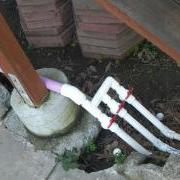 With a lot of help from our neighbor, Marc Salmon of Marc Salmon construction, we developed and executed a plan. Here is what we came up with. Our local code requires that any grey water system be divided into three zones so that water can rotated between
With a lot of help from our neighbor, Marc Salmon of Marc Salmon construction, we developed and executed a plan. Here is what we came up with. Our local code requires that any grey water system be divided into three zones so that water can rotated between 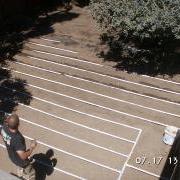 areas. Marc created a manifold with 3 manual valves for the 3 different zones. This turned out be a wise move. The west side of the lawn is shaded by the deck for part of the day and so that end of the lawn needed a lot less water than the other two zones. I scavenged most of the PVC pipe and fittings second hand off of Craigslist.
areas. Marc created a manifold with 3 manual valves for the 3 different zones. This turned out be a wise move. The west side of the lawn is shaded by the deck for part of the day and so that end of the lawn needed a lot less water than the other two zones. I scavenged most of the PVC pipe and fittings second hand off of Craigslist. 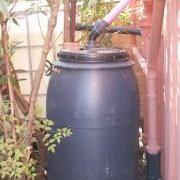 We repurposed one of our woefully undersized rain barrels to be the grey water holding tank. We
We repurposed one of our woefully undersized rain barrels to be the grey water holding tank. We 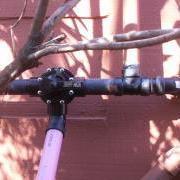 did have to buy a new Jandy valve and some new "purple" pipe (looks pink to me) that is specified for grey water where the pipe was going to be exposed.
did have to buy a new Jandy valve and some new "purple" pipe (looks pink to me) that is specified for grey water where the pipe was going to be exposed.
We got the lawn in late during the summer of 2009. The pipes and lawn went in a few weeks before the barrel, Jandy valve and plumbing from the bathtub went in. The first few weeks we watering the lawn almost daily as the weather was very hot and the lawn needed to get established. We noticed a big difference once the grey water system was connected. We dropped to watering about once per week. Im hoping that next summer all of the lawns water need will be provided by the grey water system once the lawn has had a year to establish itself.
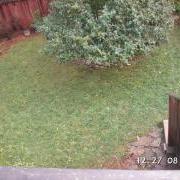 Again we are thankful for our chickens. I think we would have had a great deal more problems with weeds coming up though the lawn if the chickens hadnt killed most of them before we put the lawn in. I know they compeletly erradicated the fox tails. They are also good lawn mowers which cuts down on the work Greg has to do with the push mower. We have some small problem with them scratching but if they airate an area too much we just keep them away from it for a while.
Again we are thankful for our chickens. I think we would have had a great deal more problems with weeds coming up though the lawn if the chickens hadnt killed most of them before we put the lawn in. I know they compeletly erradicated the fox tails. They are also good lawn mowers which cuts down on the work Greg has to do with the push mower. We have some small problem with them scratching but if they airate an area too much we just keep them away from it for a while.
The big problem we have had is with grubs. The racoons and skunks come and dig up the lawn at night looking for gurbs. Im still trying to figure out how to get rid of the grubs without introducing anything that might harm our chickens or our family.
Thus far we havnt had any of the typical problems of clogging or stipes appearing in the lawn in the spaces between the pipes. For the moment we are crediting this to the fact that we have a high clay soil so the water hangs around and has time to spread out from the pipes. Only time will tell if we have a problem with root infiltration. We will keep you posted on how it goes next summer. After we are more confidiant of they systems ability to perform, we will post the plans for the system.
- Log in to post comments